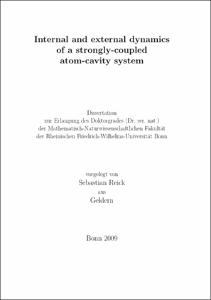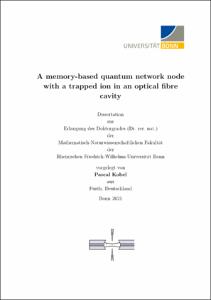Reick, Sebastian: Internal and external dynamics of a strongly-coupled atom-cavity system. - Bonn, 2010. - Dissertation, Rheinische Friedrich-Wilhelms-Universität Bonn.
Online-Ausgabe in bonndoc: https://nbn-resolving.org/urn:nbn:de:hbz:5N-19901
Online-Ausgabe in bonndoc: https://nbn-resolving.org/urn:nbn:de:hbz:5N-19901
@phdthesis{handle:20.500.11811/4504,
urn: https://nbn-resolving.org/urn:nbn:de:hbz:5N-19901,
author = {{Sebastian Reick}},
title = {Internal and external dynamics of a strongly-coupled atom-cavity system},
school = {Rheinische Friedrich-Wilhelms-Universität Bonn},
year = 2010,
month = jan,
note = {A system comprised of a small number of neutral atoms coupled to the mode of a high finesse optical resonator is a model system to study light-matter interaction at the quantum level and to explore fundamental effects like the influence of the measurement process on the atomic state. Promising proposals to generate entangled states in such systems are based on the simultaneous coupling of two atoms to one resonator mode.
In chapter 1 of this thesis I shortly summarise the experimental tools to capture, trap, and transport single atoms using a magneto-optical trap and an optical conveyor belt. I discuss theoretical foundations to describe our system and present numerical simulations, the results of which enter the analysis of our experimental data. The average atom-cavity coupling strength is deduced from the measured cavity transmission and compared to a model taking atomic motion into account.
The dynamics of the hyperfine spin state of one and two coupled atoms is the focus of chapter 2. I describe a nondestructive cavity-based state detection method, quantify the state detection fidelity, and identify optimum experimental parameters. This method is then used to record random telegraph signals, exhibiting quantum jumps on a timescale of milliseconds. Telegraph signals for two atoms are analysed employing Bayesian statistics, yielding additional information on the evolution of the hyperfine states.
A good localisation of the atom is necessary to achieve stable coupling to the cavity mode. In chapter 3, I discuss two different aspects of how the motion of the atom can be controlled. Firstly an intracavity dipole trap is characterised and it is shown that it results in improved confinement of the atom. Secondly I examine the dependence of cavity-cooling forces on our experimental parameters and compare two different cooling regimes.},
url = {https://hdl.handle.net/20.500.11811/4504}
}
urn: https://nbn-resolving.org/urn:nbn:de:hbz:5N-19901,
author = {{Sebastian Reick}},
title = {Internal and external dynamics of a strongly-coupled atom-cavity system},
school = {Rheinische Friedrich-Wilhelms-Universität Bonn},
year = 2010,
month = jan,
note = {A system comprised of a small number of neutral atoms coupled to the mode of a high finesse optical resonator is a model system to study light-matter interaction at the quantum level and to explore fundamental effects like the influence of the measurement process on the atomic state. Promising proposals to generate entangled states in such systems are based on the simultaneous coupling of two atoms to one resonator mode.
In chapter 1 of this thesis I shortly summarise the experimental tools to capture, trap, and transport single atoms using a magneto-optical trap and an optical conveyor belt. I discuss theoretical foundations to describe our system and present numerical simulations, the results of which enter the analysis of our experimental data. The average atom-cavity coupling strength is deduced from the measured cavity transmission and compared to a model taking atomic motion into account.
The dynamics of the hyperfine spin state of one and two coupled atoms is the focus of chapter 2. I describe a nondestructive cavity-based state detection method, quantify the state detection fidelity, and identify optimum experimental parameters. This method is then used to record random telegraph signals, exhibiting quantum jumps on a timescale of milliseconds. Telegraph signals for two atoms are analysed employing Bayesian statistics, yielding additional information on the evolution of the hyperfine states.
A good localisation of the atom is necessary to achieve stable coupling to the cavity mode. In chapter 3, I discuss two different aspects of how the motion of the atom can be controlled. Firstly an intracavity dipole trap is characterised and it is shown that it results in improved confinement of the atom. Secondly I examine the dependence of cavity-cooling forces on our experimental parameters and compare two different cooling regimes.},
url = {https://hdl.handle.net/20.500.11811/4504}
}









